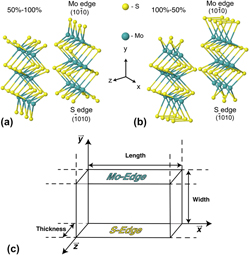Crossref Citations
This article has been cited by the following publications. This list is generated based on data provided by
Crossref.
Akdim, Brahim
Pachter, Ruth
and
Vaia, Richard A.
2014.
Tunability in electron transport of molybdenum chalcogenide nanowires by theoretical prediction.
Chemical Physics Letters,
Vol. 615,
Issue. ,
p.
99.
Kumar, Ashok
and
Ahluwalia, P.K.
2014.
Electronic transport and dielectric properties of low-dimensional structures of layered transition metal dichalcogenides.
Journal of Alloys and Compounds,
Vol. 587,
Issue. ,
p.
459.
Maijenburg, A. Wouter
Regis, Morrisa
Hattori, Azusa N.
Tanaka, Hidekazu
Choi, Kyoung-Shin
and
ten Elshof, Johan E.
2014.
MoS2 Nanocube Structures as Catalysts for Electrochemical H2 Evolution from Acidic Aqueous Solutions.
ACS Applied Materials & Interfaces,
Vol. 6,
Issue. 3,
p.
2003.
Ouyang, Fangping
Yang, Zhixiong
Ni, Xiang
Wu, Nannan
Chen, Yu
and
Xiong, Xiang
2014.
Hydrogenation-induced edge magnetization in armchair MoS2 nanoribbon and electric field effects.
Applied Physics Letters,
Vol. 104,
Issue. 7,
Yun, Won Seok
and
Lee, J. D.
2014.
Unexpected strong magnetism of Cu doped single-layer MoS2 and its origin.
Phys. Chem. Chem. Phys.,
Vol. 16,
Issue. 19,
p.
8990.
Lucking, Michael C.
Bang, Junhyeok
Terrones, Humberto
Sun, Yi-Yang
and
Zhang, Shengbai
2015.
Multivalency-Induced Band Gap Opening at MoS2 Edges.
Chemistry of Materials,
Vol. 27,
Issue. 9,
p.
3326.
Yang, Lei
Hong, Hao
Fu, Qi
Huang, Yuefei
Zhang, Jingyu
Cui, Xudong
Fan, Zhiyong
Liu, Kaihui
and
Xiang, Bin
2015.
Single-Crystal Atomic-Layered Molybdenum Disulfide Nanobelts with High Surface Activity.
ACS Nano,
Vol. 9,
Issue. 6,
p.
6478.
Cho, Soo-Yeon
Kim, Seon Joon
Lee, Youhan
Kim, Jong-Seon
Jung, Woo-Bin
Yoo, Hae-Wook
Kim, Jihan
and
Jung, Hee-Tae
2015.
Highly Enhanced Gas Adsorption Properties in Vertically Aligned MoS2 Layers.
ACS Nano,
Vol. 9,
Issue. 9,
p.
9314.
Evarestov, R. A.
2015.
Theoretical Modeling of Inorganic Nanostructures.
p.
611.
Farmanbar, Mojtaba
Amlaki, Taher
and
Brocks, Geert
2016.
Green's function approach to edge states in transition metal dichalcogenides.
Physical Review B,
Vol. 93,
Issue. 20,
Yakovkin, I.N.
and
Petrova, N.V.
2016.
Influence of the thickness and surface composition on the electronic structure of FeS 2 layers.
Applied Surface Science,
Vol. 377,
Issue. ,
p.
184.
Lazar, Petr
and
Otyepka, Michal
2017.
Role of the Edge Properties in the Hydrogen Evolution Reaction on MoS2.
Chemistry – A European Journal,
Vol. 23,
Issue. 20,
p.
4863.
Yang, Lei
Xie, Chenggen
Jin, Juncheng
Ali, Rai
Feng, Chao
Liu, Ping
and
Xiang, Bin
2018.
Properties, Preparation and Applications of Low Dimensional Transition Metal Dichalcogenides.
Nanomaterials,
Vol. 8,
Issue. 7,
p.
463.
Evarestov, R. A.
2020.
Theoretical Modeling of Inorganic Nanostructures.
p.
631.
Sayed‐Ahmad‐Baraza, Yuman
and
Ewels, Christopher P.
2020.
Stability, Structure and Reconstruction of 1H‐Edges in MoS2.
Chemistry – A European Journal,
Vol. 26,
Issue. 29,
p.
6686.
Samy, Omnia
Zeng, Shuwen
Birowosuto, Muhammad Danang
and
El Moutaouakil, Amine
2021.
A Review on MoS2 Properties, Synthesis, Sensing Applications and Challenges.
Crystals,
Vol. 11,
Issue. 4,
p.
355.
Khan, Mayur
Tripathi, Madhvendra Nath
and
Tripathi, Ambuj
2022.
Strain-induced structural, elastic, and electronic properties of 1L-MoS2.
Journal of Materials Research,
Vol. 37,
Issue. 20,
p.
3340.
Song, Pengfei
Ou, Pengfei
Wang, Yongjie
Yuan, Hang
Duan, Sixuan
Chen, Longyan
Fu, Hao
Song, Jun
and
Liu, Xinyu
2023.
An ultrasensitive FET biosensor based on vertically aligned MoS2 nanolayers with abundant surface active sites.
Analytica Chimica Acta,
Vol. 1252,
Issue. ,
p.
341036.
Janjhi, Farooque Ahmed
Chandio, Imamdin
Janwery, Dahar
Memon, Ayaz Ali
Thebo, Khalid Hussain
Boczkaj, Grzegorz
Vatanpour, Vahid
and
Castro-Muñoz, Roberto
2023.
MoS2-containing composite membranes for separation of environmental energy-relevant liquid and gas mixtures: A comprehensive review.
Chemical Engineering Research and Design,
Vol. 199,
Issue. ,
p.
327.
Namita
Khan, Ariba
Arti
Alam, Naushad
Sadasivuni, Kishor K.
and
Ansari, Jamilur R.
2024.
MoS2 quantum dots and their diverse sensing applications.
Emergent Materials,





